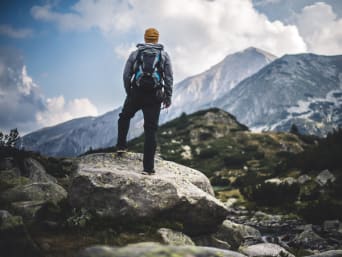Hiking alone, with children or in a group – what suits you best?
Hiking for beginners & enthusiasts
From a demanding trekking tour to a relaxed family hike: hiking as a hobby is very flexible and can be adapted to your individual needs and ideas. You can go for a relaxed day's hike on flat terrain with the whole family or seek a physical challenge on a long-distance hike lasting several days. As with any sport, there are different forms of hiking, which place different demands on the hiker and require different levels of fitness.
In this article, we will explain the differences between popular types of hiking and show you which forms are suitable for beginners, families with children and advanced hikers. We will also give you tips on planning and preparing your hike, whether you would like to hike alone, in a group or with your children.
Types of hiking at a glance
Any experienced hiker will tell you that not all types of hiking are the same. If you are planning a more extensive hiking tour for the first time, you will certainly come across the most diverse variants of this popular outdoor sport during your research. What is pleasure walking and what is the difference between trekking and long-distance hiking? What are the characteristics of mountain hiking or trekking? Below we will briefly explain some of the most popular types of hiking.
What is pleasure walking?
Pleasure walking is a term used to describe hiking routes that are quite easy. The main focus of this type of hiking is enjoying the countryside and gentle physical activity. Pleasure walks are particularly suitable for beginners and families who would like to go hiking with their children. As pleasure hikes are primarily intended for recreation, they usually lead along well-developed hiking trails on flat terrain.
What is a themed hiking trail?
Themed hiking trails are specially designed hiking routes that highlight certain historical, cultural or natural features or events. These are usually themes with local or regional significance (fairy tales and legends, historical events, animal habitats). Themed hiking trails use information boards and interactive stations along the trail to convey knowledge in an easy-to-understand way and motivate visitors to explore the region in more depth. Themed hiking trails are closely related to educational trails, however, on this kind of trail the educational aspect is more important than the physical activity.

Geocaching: a hiking adventure
Geocaching is a modern form of a scavenger hunt or treasure hunt. Participants can use GPS devices (e.g. smartphone apps) to find hidden containers called "caches" whilst hiking. These caches are located along the routes and contain logbooks to write in and sometimes also small items to exchange. Geocaching adds an interactive and playful component to hikes, combining the experience of nature with a sense of adventure. Geocaching is ideal for making hikes more exciting and attractive for children and young people, which is why this type of hike is also promoted by many regional hiking clubs.
Long-distance hiking
Long-distance hiking refers to hikes over a long distance that take several days. They can be very long and go through several different countries and regions. Some long-distance hikes loop around and lead back to the starting point, but often the hike will end in a completely different place. They range from 6 stages to 30 or even a lot more stages.
If you are a beginner or hiking with children, it is a good idea to only hike specific sections of a long-distance hiking trail and stick to flatter and easier sections. You should be an experienced hiker and be in good shape to complete several sections in one go or even an entire long-distance trail.
Trekking
Trekking is also a multi-day hike that, unlike a classic long-distance hike, often leads you away from roads or marked trails. In addition, trekking is often done without fixed accommodation. Instead, on a trekking tour, you will usually carry your tent, sleeping bag, food and drink with you, and sleep in huts along the way. Since trekking requires more gear, experience with different weather conditions and knowledge of what to do in emergency situations. It also requires good preparation and is recommended for more experienced hikers.

For many people, a friendly greeting to oncoming hikers is part of "hiking etiquette". On long-distance hikes, people often have a brief chat, ask some questions about the route or weather, and maybe exchange a friendly anecdote.
Mountain hiking
This hiking discipline refers to hiking in the mountains or on mountainous terrain. This demanding type of hiking is best suited for ambitious hikers with a good level of fitness. You should be sure-footed and not be afraid of heights.
The boundary between mountain hiking and mountaineering cannot be defined by altitude or differences in altitude. However, mountain hiking does not need specialist equipment like crampons or safety ropes. Another rule of thumb is that mountaineering requires you to use your hands for climbing.
Group hiking, family hiking or hiking alone: which hike suits you best?
Various factors can influence which type of hiking type and route you choose. To plan a hike, you should consider what your goals are for your tour.
How much time do you have for your hike? You can plan a hike as a weekend excursion, a hiking holiday or a maybe even over several months.
How long should your hiking tour be? Choose between day hikes without an overnight stay, long-distance hikes lasting several days or even extended long-distance hikes through several countries.
How experienced are you in hiking? Do you consider yourself a newcomer to hiking, an experienced hiker or a seasoned long-distance hiker? What (sporting) skills do you have? How steady is your footing and are you afraid of heights?
What is most important to you during your tour? Whether you want to experience nature, go on a pilgrimage or create shared memories with family and friends, these factors will influence how and where you hike.
Who do you want to hike with? Who you decide to go on a hike with, plays an important role in which route you choose and how you prepare (e.g. with children, in a hiking group, or hiking alone).
Whether you are planning a leisurely hike, want to hike with your family or are looking for a sporting challenge, you are sure to find a suitable hike for your "hiking type". Here are some of the options:
Family hiking: how to plan a hike with children
Go on adventures in the countryside and enjoy spending time with your family. Hiking with children can be a great experience for the whole family. To get your kids interested in outdoor sports at an early age, it is often necessary to make adjustments when selecting and planning a route so that the hike is child- and family-friendly.
Choose a route that is manageable for your child. You can calculate how long your hike should be by using the rule of thumb: age x 1.5 = trail length in kilometres. For hiking trails with a lot of hills, you should bear in mind that experts consider 100 metres of altitude as one kilometre on level terrain. More demanding hikes, including long-distance hikes, are often recommended for ages 10 to 14 and older. Nevertheless, keep in mind the maximum walking time should not exceed 6 to 7 hours.
Plan enough breaks. Even if your child is in good shape, children generally need frequent and longer breaks to restore their energy levels. You know your child best and can judge how long and how many breaks you should plan. It is also important to offer your child activities on a hike to keep them motivated. For example, occasional games or discovering nature together are suitable for family hikes.
Plan ahead to ensure the safety of your child. Find out about specific challenges and difficulties on your route. It’s recommended to hold your child’s hand on difficult sections. Even though your children don’t need to be by your side all the time, you should always have an eye on them.
Depending on the age of your child, involve them in your planning. Why not choose a route with interesting sections together? Older children can also take the lead on safe sections, e.g. reading the map or looking for the right path.
Make the hike an adventure to awaken your children's enthusiasm. The countryside offers many things for children to exploreyou might discover animal tracks in the forest, find different plant species, or simply take a break and enjoy the lovely view. A picnic or campfire, if allowed, is also a good way to liven up your family hike.
Hiking alone: what you should know when planning your trip
Being alone in nature without a hiking group is a dream for many hikers. You can enjoy the sporting challenge and the experience of nature without distractions and concentrate entirely on yourself. As a lone hiker, you set the pace and determine your own destination. However, to ensure your safety throughout, you should take a few things into account when planning:
Inform someone close to you about your planned route and approximate arrival times. Be aware of possible delays or diversions from the route. If you are planning a long-distance hike, you should keep in regular contact with your loved ones.
Choose familiar regions or routes for your first solo hikes. Hiking alone for the first time is an exciting challenge. However, to keep your bearings and overview, you should choose familiar routes or hike in familiar areas.
Choose hiking routes with signs and places to rest. If you have problems along the way or you would like to get into contact with other people, it is helpful to stay close to well-used paths and rest stops.
Use the official paths. This will help you pinpoint your position and assess the difficulty of the terrain.
Tip: For multi-day hikes, it is recommended to sign the logbooks in the huts you stay in and at the summit. This will track the course of your route in case you need help during your hike.
Hiking with friends: how to plan a group hike
Do you have many like-minded hiking enthusiasts in your circle of friends? Or do you simply want to go on an active holiday together with good friends and leave the daily grind behind you? On a hike with friends, surrounded by unique landscapes, you can create shared memories that you will remember for a long time. Here are a few tips to help you plan your trip:
Agree on a route before you start your hike. Discuss not only the location and personal preferences, but also how long you would like to go hiking. Which sights are you interested in? How do you want to spend the night? How many breaks do you want to take?
Discuss your individual fitness level and hiking experience beforehand. When planning your hike, make sure that it is manageable even for the least experienced participant. Choose the length and difficulty of the hike accordingly.
When hiking in a group, pay attention to each other and maintain communication during the hike. This will ensure the safety and well-being of the whole group. If someone needs a break or wants to look at place of interest off-route, this should be discussed beforehand. Compromises can prevent disagreements and frustration in the group.

Do not overestimate your own abilities and energy levels, especially on demanding hikes through the mountains. For tours with high technical demands or risky terrain, you can hire a mountain guide.
Conclusion: hiking with friends, in a group or with your children – planning is crucial
The type of hiking experience you would like, and the people whom you choose to hike with, will determine which route you choose and how you plan your hike. Whether you have sporting ambitions or simply want to get away from it all for a while, safety is always a priority. Always take the weakest members of the group into consideration, both for hiking groups and for family hikes. If you are hiking alone, it is most important to choose familiar areas and safe hiking trails with signs. This way, with a little experience, you can master even challenging hikes without any problems.
______________________________________________
References and further information
https://hikingguy.com/how-to-hike/hiking-for-beginners-11-essential-tips/
(last accessed on 30.04.2024)
https://www.explore-share.com/blog/differences-between-hiking-and-mountaineering/
(last accessed on 30.04.2024)
https://www.getoutwiththekids.co.uk/family-hiking/how-to-go-hiking-with-kids/
(last accessed on 30.04.2024)
https://www.parents.com/fun/activities/outdoor/10-reasons-to-take-a-family-hike/
(last accessed on 30.04.2024)
https://totalhiker.com/types-of-hiking/
(last accessed on 30.04.2024)
https://trailandsummit.com/what-are-the-different-types-of-hiking/
(last accessed on 30.04.2024)
The image sources in this text are in chronological order
Cover photo: iStock.com/molchanovdmitry
1. Image in text: iStock.com/Alexander Chernyakov
2. Image in text: iStock.com/BartekSzewczyk
3. Image in text: iStock.com/Geber86







